Politics
Hurricane Melissa’s death toll climbs to 44, storm churns north
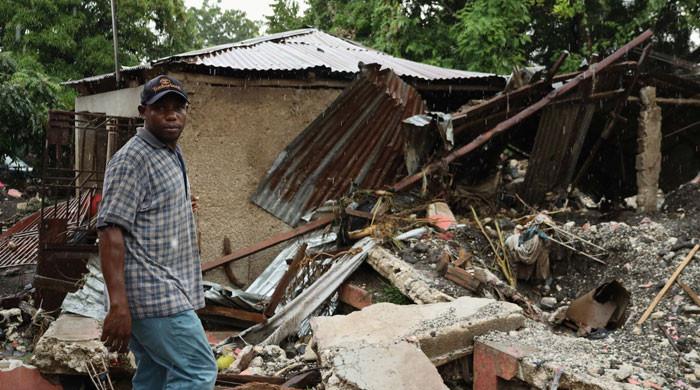
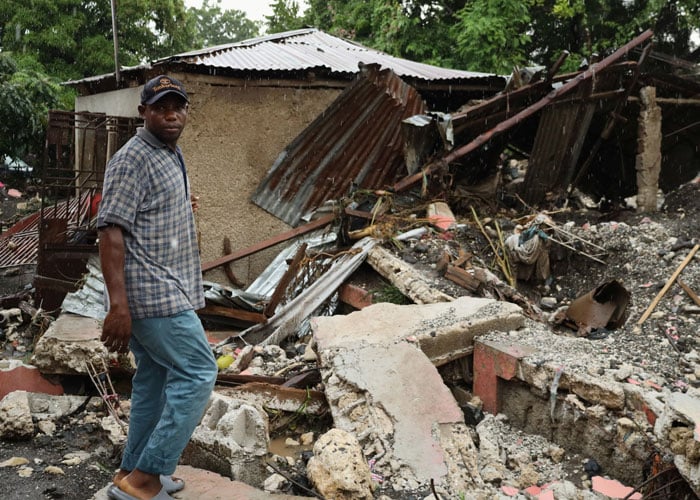
- At least 25 confirmed dead in Haiti, 19 in Jamaica.
- Forecaster estimates up to $52 billion in damages.
- Melissa among strongest-ever storms at landfall.
PORT-AU-PRINCE/KINGSTON/HAVANA: Hurricane Melissa’s confirmed death toll climbed to 44 on Thursday, according to official reports, after wreaking destruction across much of the northern Caribbean and picking up speed as it headed toward Bermuda.
Jamaica’s information minister told Reuters at least 19 deaths had been confirmed, but authorities were continuing search and rescue efforts. The storm left hundreds of thousands without power, ripped roofs of buildings and scattered fields with rubble.
Jamaica’s military has called on reserve personnel to report for duty to help with relief and rescue operations.
Melissa made landfall in southwestern Jamaica on Tuesday as a powerful Category 5 hurricane, the Caribbean nation’s strongest-ever storm to directly hit its shores, and the first major hurricane to do so since 1988.
Windspeeds were well above the minimum level for the strongest hurricane classification. Forecasters at AccuWeather said it tied in second place for strongest-ever Atlantic hurricane on record in terms of windspeed when in struck land.
The forecaster estimated $48 billion to $52 billion in damage and economic loss across the western Caribbean.
Authorities in Haiti, which was not directly hit but nevertheless suffered days of torrential rains from the slow-moving storm, reported at least 25 deaths, mostly in the southern town of Petit-Goave when a river burst its banks.
A river also caved in and carried off part of a national highway, local newspaper Le Nouvelliste reported. The road, which had been weakened by last year’s Hurricane Beryl, connected to the nearby city of Jacmel.
Melissa also hit eastern Cuba, where some 735,000 evacuated, but as of Thursday, no deaths were reported there, despite extensive damage to homes and crops.
At 8pm (0000 GMT), Melissa was a Category 1 storm 409 km (254 miles) south-west of the North Atlantic British island territory, where hurricane conditions were expected by nightfall even as Melissa’s eye skirts north-west.
Melissa was packing maximum sustained winds of 105 mph (169 kph).
Residents in Bermuda however remained calm as the storm was expected to give the island a relatively wide berth. Authorities said they would close its causeway Thursday night and shut schools and ferries on Friday “out of an abundance of caution.”
In the Bahamas, which Melissa cut through Wednesday night, authorities lifted storm warnings but did not give the “all clear”. An official said authorities expected to decide by Saturday whether it was safe for the hundreds of people who evacuated off affected islands to return to their homes.
Wading barefoot through mud
The front page of Thursday’s Jamaica Observer newspaper read: “DEVASTATION.”
Densely populated Kingston was spared the worst damage. Its main airport was set to reopen on Thursday, as was the capital’s port. Relief flights and aid had begun to flow into Jamaica’s airports, authorities said.
But across the country, more than 130 roads remained blocked by trees, debris and electric lines, authorities said, forcing the military to clear roadways on foot into isolated areas, with ambulances following close behind.
Satellite imagery showed swaths of trees and homes devastated in the hardest-hit areas of Jamaica, sparse remaining greenery defoliated and most structures destroyed.
In a neighbourhood of the island’s Montego Bay, 77-year-old Alfred Hines waded barefoot through thick mud and debris as he described his narrow escape from the rising floodwaters.
“At one stage, I see the water at my waist and (after) about 10 minutes time, I see it around my neck here and I make my escape,” he told Reuters on Wednesday.
“I just want to forget it and things come back to normal.”
In western parts of the island, people crowded by supermarkets and gas stations to fill up on supplies.
“Montego Bay hasn’t got any petrol. Most of the petrol stations are down,” British tourist Chevelle Fitzgerald told Reuters, adding it took her at least six hours to cross the 174 km (108 miles) to Jamaica’s capital.
“The highway was closed. You had some blockage on the road and trees falling down,” she said.
Over 70% of electrical customers in Jamaica remained without power as of Thursday morning, said Energy Minister Daryl Vaz, with power lines felled across the island’s roadways.
Many schools remained without power or water, officials in the capital Kingston said.
Immediate humanitarian aid
Scientists say hurricanes are intensifying faster with greater frequency as a result of warming ocean waters caused by greenhouse gas emissions. Many Caribbean leaders have called on wealthy, heavy-polluting nations to provide reparations in the form of aid or debt relief.
Despite the U.N. setting up a fund for developing nations to quickly access reliable financing for more extreme weather events in 2023, donations have not met targets.
U.S. forecaster AccuWeather said Melissa was the third most-intense hurricane observed in the Caribbean, as well as its slowest-moving, compounding damages for affected areas.
U.S. search and rescue teams were headed for Jamaica on Thursday to assist in recovery efforts, Jamaican authorities said. U.S. Secretary of State Marco Rubio said the U.S. was prepared to offer “immediate humanitarian aid” to the people of Cuba, a long-time U.S. foe.
Authorities in Cuba – which Melissa struck in the night as a Category 3 storm – said they were “awaiting clarification on how and in what way they are willing to assist.”
At least 241 Cuban communities remained isolated and without communications on Wednesday following the storm’s passage across Santiago province, according to preliminary media reports, affecting as many as 140,000 residents.
Residents of Santiago, Cuba’s second-largest city, began returning to repair their homes. Authorities had evacuated 735,000 people to shelters outside the hurricane’s cone and relocated tourists in northern cays to inland hotels.
Politics
Trump’s ‘Presidential Walk of Fame’ at White House features mocking, controversial plaques targeting former presidents
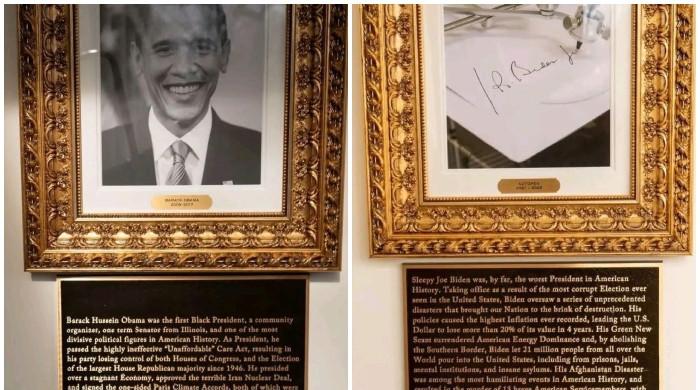
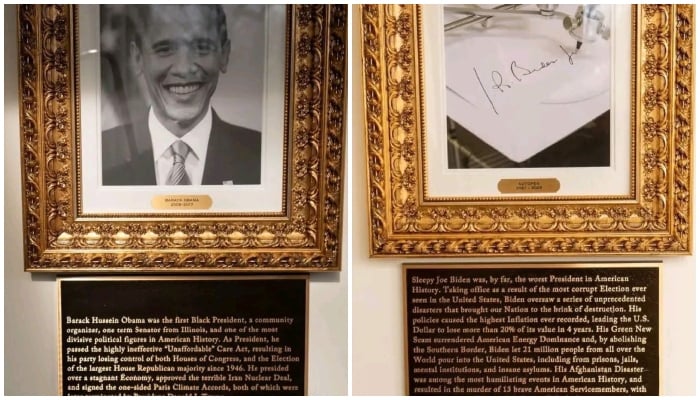
WASHINGTON: US President Donald Trump has installed new plaques at the “Presidential Walk of Fame” located along the West Wing Colonnade of the White House.
The plaques contain direct and politically charged, mocking commentary aimed at recent former US presidents. Reporters spotted the new additions on Wednesday, triggering fresh debate within Washington’s political circles.
One plaque refers to former president Joe Biden as “Sleepy Joe Biden” and labels him “the worst president in American history.” Notably, Biden’s portrait is absent from the walk of fame. Instead, a framed image shows Biden’s signature produced by the presidential autopen.
Former president Barack Obama’s plaque identifies him as “Barack Hussein Obama” and describes him as “one of the most divisive political figures in American history.”
Similarly, the plaque beneath Bill Clinton’s portrait states that “in 2016, President Clinton’s wife, Hillary Clinton, lost the presidency to President Donald J. Trump.”
According to the White House, several of these plaques were written by President Trump himself. These additions are being described as part of Trump’s broader effort to reshape the White House in line with his political vision.
The White House formally unveiled the Presidential Walk of Fame outside the Oval Office in September. The display includes portraits of all past US presidents, with the exception of Joe Biden.
President Trump has previously overseen other major changes at the White House, including replacing the grass in the Rose Garden with a stone patio and ordering the construction of a new White House ballroom, a project that required the demolition of much of the East Wing.
Political analysts say the plaques represent an unprecedented move in American history, marking the first time such overtly political and controversial narratives about former presidents have been publicly displayed inside the White House. Strong reactions and further debate are expected in the coming days.
Politics
Three killed in Taipei metro attacks, suspect dead
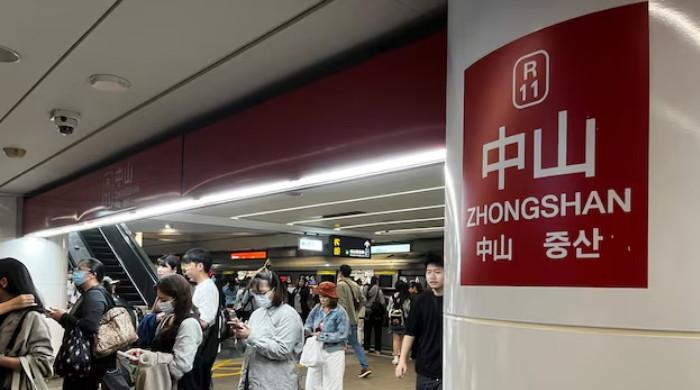

Attacks at metro stations in Taipei on Friday involving smoke bombs and stabbings killed at least three people, the Taiwanese city’s fire department said, adding that the suspect was also dead.
Taiwan’s Premier Cho Jung-tai said the attacks at Taipei Main Station and Zhongshan Station were “a deliberate act”, although the motive was not immediately clear.
Cho said in a statement that the suspect wore a mask and threw “five or six gasoline bombs or smoke grenades” at Taipei Main Station.
According to the Taipei City Fire Department, a total of four people were confirmed dead, including the suspect, a 27-year-old man.
Five other people were injured, the fire department said.
The city’s mayor said the suspect had apparently jumped off a building and that he was wanted for evading military service.
One of the victims was killed while trying to stop the attack at the Main Station, Mayor Chiang Wan-an told reporters.
“Unfortunately, he was attacked and passed away… we are all deeply saddened,” he said.
A witness of the attack at the Main Station told local network EBC News that he had seen a “man rush up and try and subdue” the attacker, who was “wearing a gas mask and a bulletproof vest”.
“At first I thought it was a drill, then I saw a person holding a knife and throwing smoke grenades,” said the witness, who did not give his name.
The mayor said that “we understand that the suspect committed suicide by jumping from a building to evade arrest, and has been confirmed dead.”
High alert
A second witness told EBC News that “someone ran out wearing a gas mask and started throwing canisters that released gas.”
“I quickly ran away. He kept throwing them behind me. I didn’t count how many (canisters) but there was a constant banging and clanging sound,” added the witness, who also did not give his name.
“I didn’t hear any explosions, but a lot of gas kept spraying out.”
Cho, the island’s premier, earlier said three people suffered cardiac arrest as a result of the attacks, and several people had “injuries from stab wounds and blunt force trauma to various parts of their bodies”.
Authorities said they were ramping up security across the island in response to the attacks.
“All important locations… including railway stations, highways, subway stations and airports are maintaining a high level of alert and vigilance,” Cho told reporters.
Images released by Taiwan’s Central News Agency show a canister on the ground at the Main Station, with officers examining potential evidence at the scene.
A video posted on social media shows a thick cloud of white smoke covering an underground section of a metro station, with some people standing at a distance.
President Lai Ching-te said Taiwanese authorities will “quickly clarify the details of the case. There will be no leniency and we will do everything in our power to ensure the safety of our citizens.”
Violent crime is rare Taiwan, though an attack in 2014 horrified the normally peaceful island when a man went on a stabbing spree on Taipei’s metro, killing four people. He was executed for the killings in 2016.
Politics
Body of Bangladesh’s youth leader reaches Dhaka amid ‘violent protests’
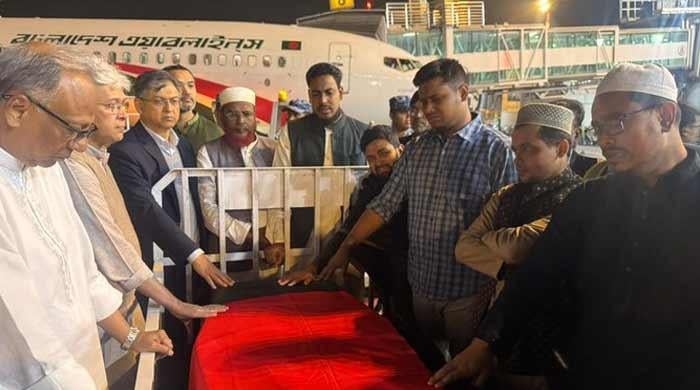
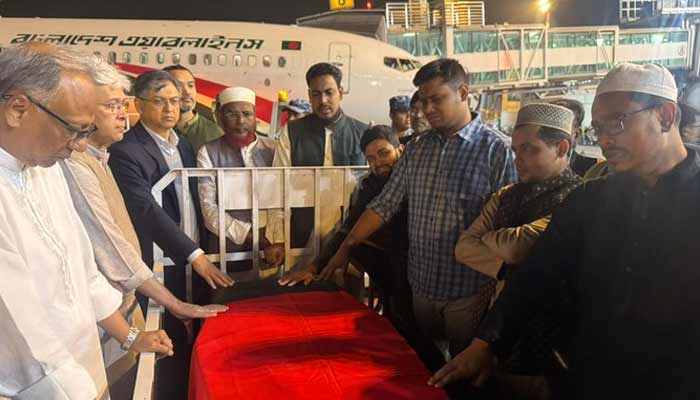
- Bangladeshis urged to resist violence committed by “fringe elements”.
- Mobs vandalise media offices, attack Indian High Commission.
- Violence to continue if justice not ensured, says activist.
The body of Osman Hadi, the popular student leader who was assassinated in Dhaka last Friday while launching his campaign for the elections, has reached the Bangladesh’s capital amid ongoing nationwide violent protests.
In a post on X, the interim government said a Biman Bangladesh Airlines flight carrying Sharif Osman Hadi’s remains landed at Hazrat Shahjalal International Airport in Dhaka at 5:48pm local time after departing from Singapore, where he was undergoing medical treatment.
Meanwhile, the interim administration urged people to resist violence as soldiers and police fanned out across Dhaka and other cities following protests, sparking fears of more unrest ahead of national elections in which he had been due to run.
The Muslim-majority nation of about 175 million people is due to elect a new parliament in less than two months’ time — a transition many hope will help the country recover from nearly two years of instability and reclaim its position as a South Asian development success story.
Frequent bouts of violent protests and political wrangling among disparate groups including hardliners have, however, punctured the national sense of euphoria that arose after student-led protests ousted powerful leader and longtime Prime Minister Sheikh Hasina in August 2024.
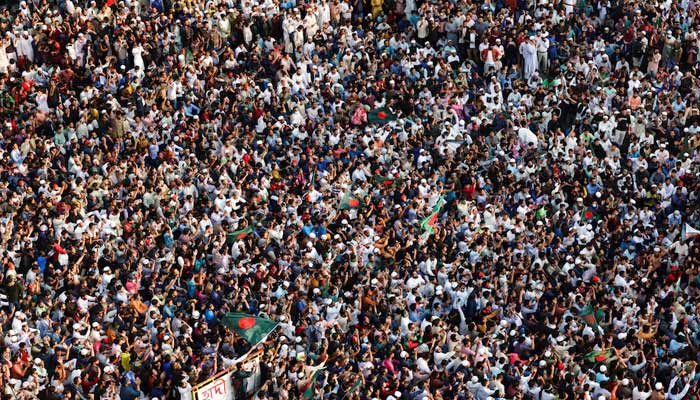
It has also exposed the limitations of the interim government headed by Nobel laureate Muhammad Yunus, analysts said, raising questions over his grip on governance in the world’s second-largest apparel producer after China.
Hasina’s party, the Awami League, which has been barred from the February 12 vote, has threatened unrest that some fear could derail the election itself.
Newspaper, Indian mission targeted
Youth leader Sharif Osman Hadi, 32, was shot in the head by masked assailants in Dhaka last Friday while launching his campaign for the elections. He was a spokesperson for the Inquilab Mancha, or Platform for Revolution, and participated in the protests that overthrew Hasina.
Hadi, an outspoken critic of India as well, was initially treated at a local hospital before being flown to Singapore for advanced medical care, where he died after six days on life support.
In Dhaka, videos circulating on social media showed mobs vandalising the offices of the country’s largest daily newspaper, Prothom Alo, as well as the Daily Star, on Thursday night.
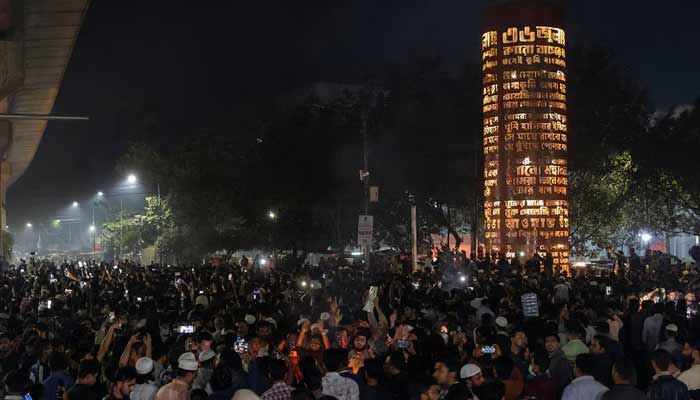
The fire service said the blaze at the Daily Star was under control. Troops were deployed to the scene, and firefighters rescued journalists trapped inside the building.
Violence was also reported in a number of cities across Bangladesh, including the port city of Chittagong, where protesters attacked the Indian Assistant High Commission.
The unrest follows fresh anti-India protests this week, with ties between the neighbours deteriorating since Hasina fled to Delhi. On Wednesday, hundreds of demonstrators marched toward the Indian High Commission in Dhaka, chanting anti-India slogans and demanding Hasina’s return.
Although calm had returned to much of the country on Friday morning, protesters carrying national flags and placards continued demonstrating at Shahbagh in central Dhaka, chanting slogans and vowing not to return until justice was served.
Government blames ‘fringe elements’
The interim government urged the people of Bangladesh to resist all forms of mob violence, it said were committed by a “few fringe elements”.
“This is a critical moment in our nation’s history when we are making a historic democratic transition,” it said in a statement. “We cannot and must not allow it to be derailed by those few who thrive on chaos and reject peace.”
The government told journalists at the Daily Star, Prothom Alo and New Age following the attacks on their offices that, “attacks on journalists are attacks on truth itself. We promise you full justice”.
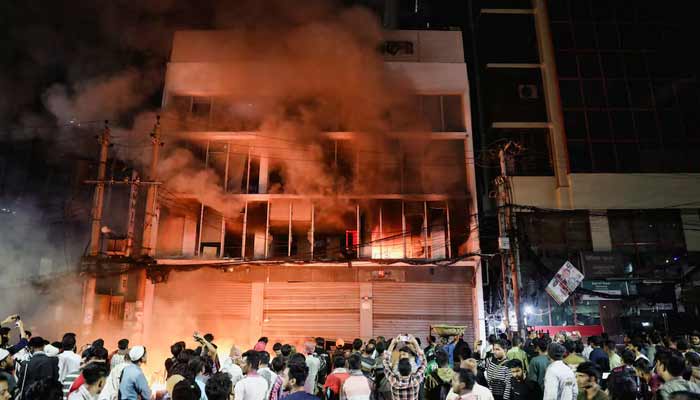
It also condemned the lynching of a Hindu man in Mymensingh district, who was beaten and set on fire over allegations of blasphemy in an unrelated incident, vowing that those responsible would be brought to justice.
Independent rights group Ain O Salish Kendra said in a statement that coordinated attacks on media outlets, cultural institutions and historical sites indicated the dangerous spread of extremist and violent thought in Bangladesh.
“This series of violence may remain a permanent crisis for the country’s human rights situation, democratic space and future generations,” if justice is not ensured and institutions protected, it said.
-

 Business6 days ago
Business6 days agoHitting The ‘High Notes’ In Ties: Nepal Set To Lift Ban On Indian Bills Above ₹100
-

 Politics1 week ago
Politics1 week agoTrump launches gold card programme for expedited visas with a $1m price tag
-

 Fashion1 week ago
Fashion1 week agoTommy Hilfiger appoints Sergio Pérez as global menswear ambassador
-

 Sports1 week ago
Sports1 week agoU.S. House passes bill to combat stadium drones
-

 Sports1 week ago
Sports1 week agoPolice detain Michigan head football coach Sherrone Moore after firing, salacious details emerge: report
-

 Business1 week ago
Business1 week agoCoca-Cola taps COO Henrique Braun to replace James Quincey as CEO in 2026
-

 Fashion1 week ago
Fashion1 week agoBrunello Cucinelli lifts 2025 revenue growth forecast to up to 12%
-

 Tech6 days ago
Tech6 days agoFor the First Time, AI Analyzes Language as Well as a Human Expert






